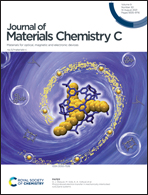A high sensitivity luminescent sensor for the stress biomarker cortisol using four-fold interpenetrated europium–organic frameworks integrated with logic gates†
Abstract
Cortisol is a reliable biomarker to evaluate human stress, as excessive stress can lead to an increased risk of cardiovascular diseases, neurogenic diseases, and sudden death. Therefore, it is necessary and important to seek a convenient and fast approach to detect cortisol, which is a great challenge. Herein, a novel four-fold interpenetrated framework {[Eu(BTB)(H2O)3]·1.5DMA·5H2O}n (MHT-1) was constructed and structurally characterized. The highly interpenetrated framework of MHT-1 endows it with high thermal, solvent and pH stabilities. Notably, MHT-1 can selectively detect cortisol with a wide concentration range from 10−9 M to 4 × 10−3 M in artificial human sweat. The corresponding sensitivity limit of MHT-1 can reach 10−9 M, which is a comparable value among those of other reported studies. In addition, MHT-1 can repeatedly detect cortisol at least 20 times without an obvious loss of sensing sensitivity. More importantly, an intelligent logic gate has been designed, providing a simple approach to detect cortisol levels in human sweat with the naked eye. This work offers a novel luminescent MOF and a technique to achieve the visual and simple detection of cortisol in human sweat with a promising practical application.



 Please wait while we load your content...
Please wait while we load your content...